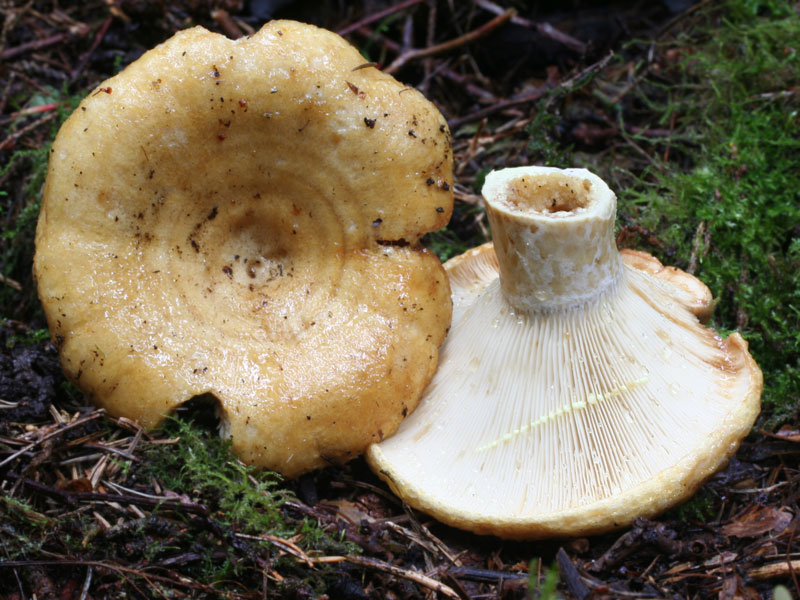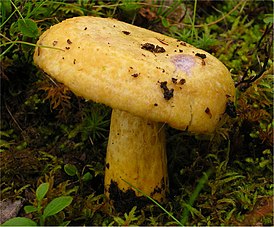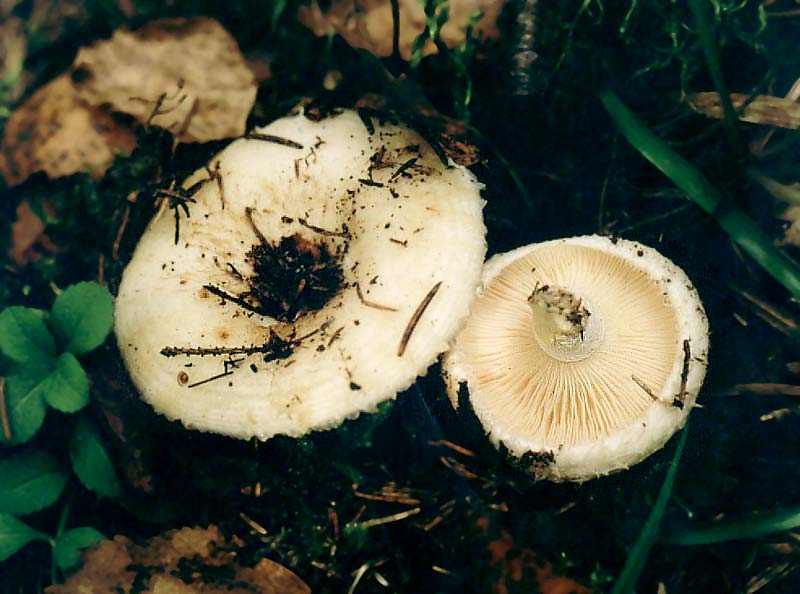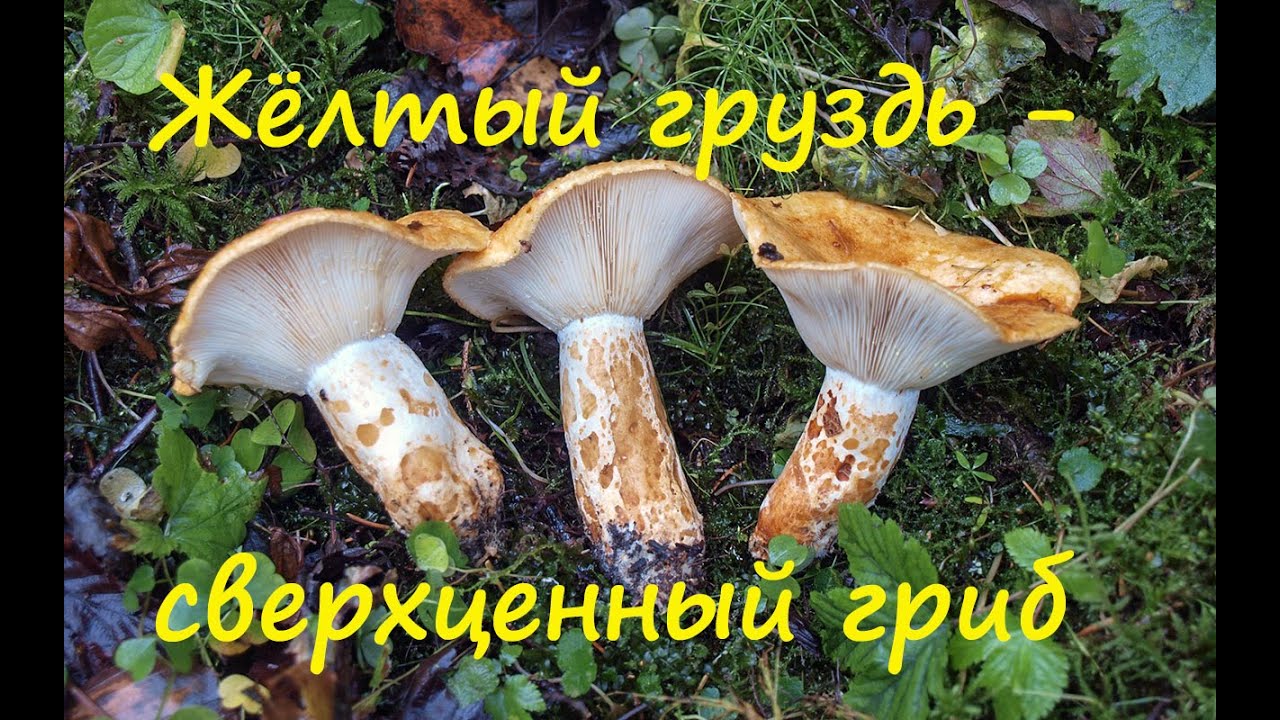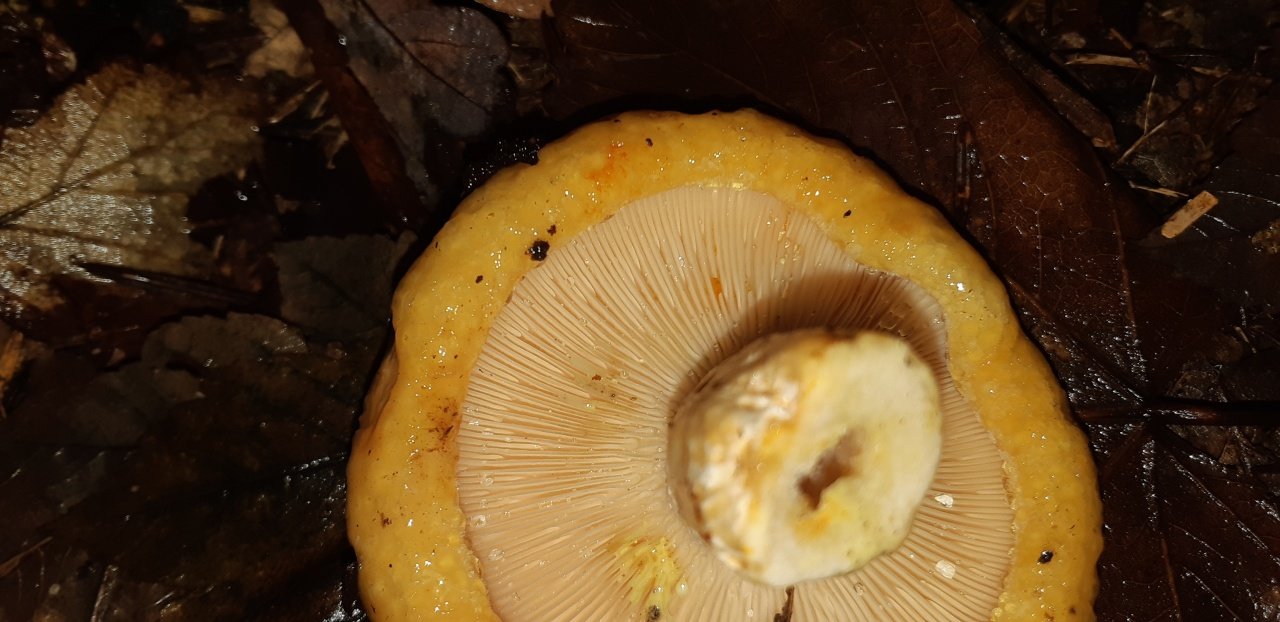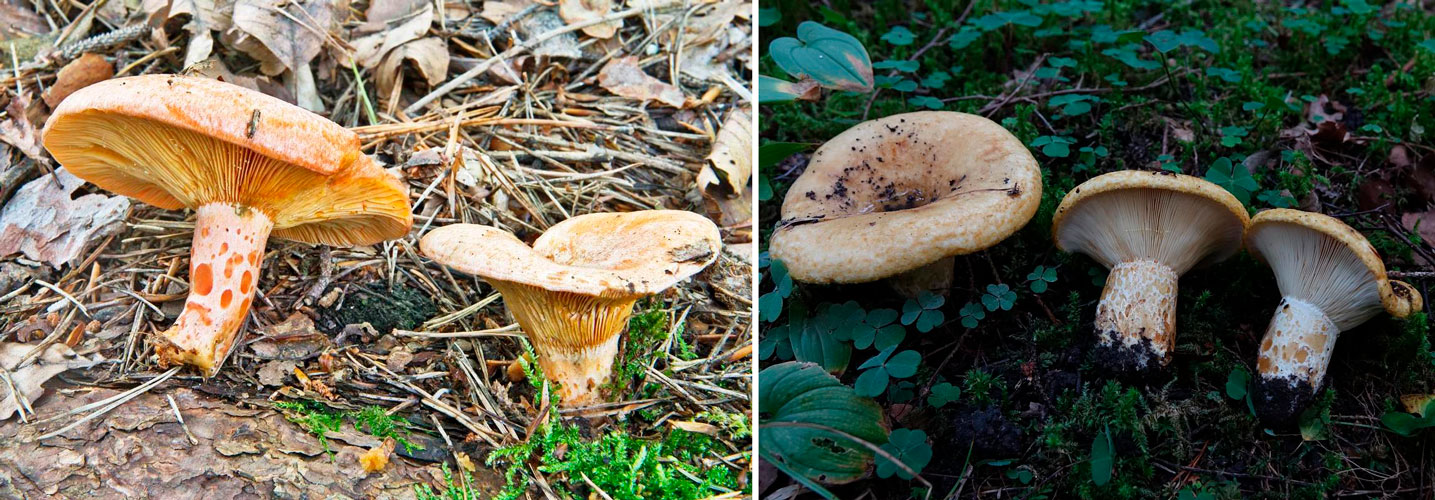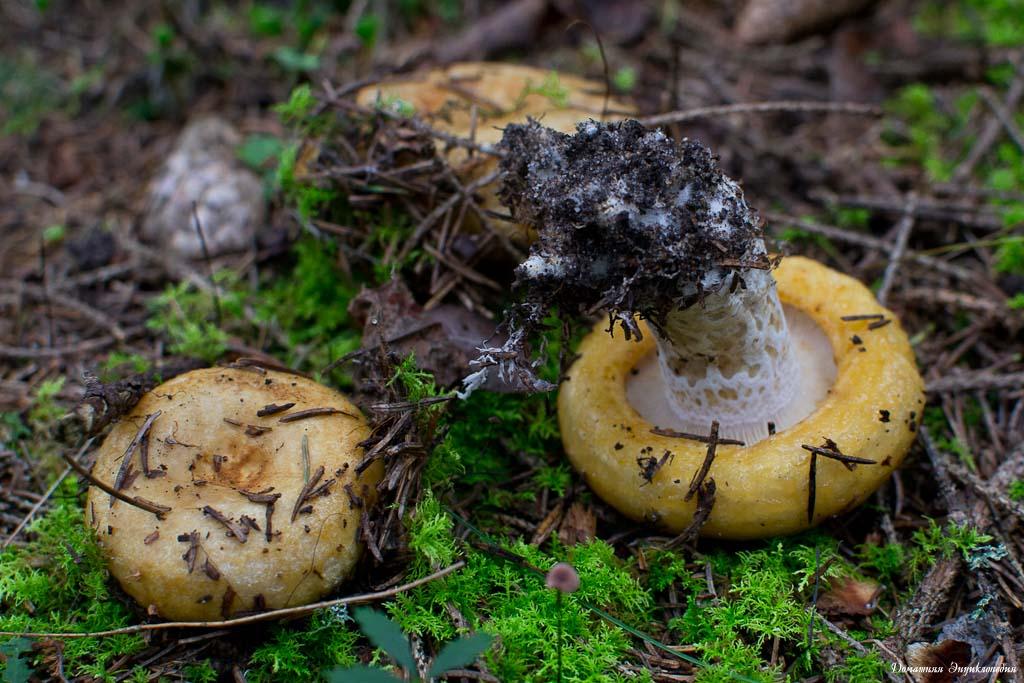The main types of mushrooms
Real Milk (Lactarius resimus)
Real Milk (Lactarius resimus)
The most famous species with excellent taste. The cap is fleshy, at first spread out, and then depressed in the center, with curved fringed edges, reaching a diameter of 20 cm. The skin is milky or with a yellow tint, sometimes with reddish spots, slimy in rainy or foggy weather.
The leg is even, up to 6 cm high, frequent creamy white plates descend onto it. The pulp is tight, white, with acrid juice, yellowing at the break. This is the best type for pickles in which the fruiting bodies take on a light blue tint.
Aspen Milk (Lactarius controversus)
Aspen Milk (Lactarius controversus)
The cap is initially flat-rounded, raised in the center, later concave, up to 30 cm in diameter, white, with reddish or purple streaks, slightly pubescent. The plates are frequent, white with a pink glow, descending to a dense stalk up to 8 cm high, which becomes narrower at the base. The pink hue of the plates is the main difference between this species and other milkers.
The pulp is milky-white, with a fruity aroma; when broken, it emits a caustic white liquid that does not darken in air.
Yellow Milk (Lactarius scrobiculatus)
Yellow Milk (Lactarius scrobiculatus)
A beautiful mushroom, with an appetizing golden cap up to 15 cm in diameter, concave in the center and fringed at the edges, slimy in rain and glossy on a sunny day. The leg is strong, small, up to 5 cm tall, with a yellowish tinge and patterned golden stains or spots.
Often located creamy plates descend to the stem. The pulp is juicy, burning juice appears on the fracture, which then darkens. Darkening may appear during collection and transportation at touch points.
Oak Milk (Lactarius insulsus)
Oak Milk (Lactarius insulsus)
The cap is open, then funnel-shaped with the edges turned down, up to 12 cm in diameter. The skin is brown-orange, with a reddish tint, covered with brown spots. Yellowish plates descend to a peduncle of the same color.
The pulp is fleshy, creamy white, when broken, it acquires a pink tint and releases a watery white liquid with a pungent taste and a slight mushroom odor. The mushroom is used for pickling and is considered conditionally edible.
In another way, oak mushroom is called oak mushroom. If you are interested in learning more about saffron milk caps, read the article "Camelina mushrooms".
Black Milk (Lactarius necator)
Black Milk (Lactarius necator)
This dark mushroom is very tasty in pickles, acquiring a wine, reddish tint. The cap is round-flat, later sunken, up to 20 cm in diameter, brownish yellow with an olive tint or dark green, the surface may be covered with concentric circles. The edges are curved, slightly fringed. The skin is slimy, especially in rainy weather.
Greenish sticky leg up to 8 cm high, tight and full, becomes hollow towards the base, the surface is covered with dents. In the upper part, thinned plates of a yellowish-olive color descend on it. The white flesh is fleshy, grayish when broken, emitting a milky liquid, which in the air acquires a lilac hue. The hat is often dirty, the surface is covered with soil particles and debris, and must be scraped before cooking.
White podgruzdok (dry lump) (Russula delica)
White podgruzdok (Russula delica)
White podgruzdok - a tasty and fragrant type of russula, a whitish-cream hat with brown stains, up to 20 cm in diameter, rounded-convex, and then concave. The plates are frequent, creamy white, falling on an even or slightly curved strong stem. The pulp is tight, creamy, with a delicate mushroom aroma and a pungent taste.
The surface is usually covered with ingrown soil particles. In dry weather, dry fabrics can crack like parchment, which is why the load got its second name.
What edible types of milk mushrooms are suitable for salting: bitter milk mushroom
Category: edible.


Above is a photo of what a bitter milk mushroom (Lactarius rufus) looks like. Its cap with a diameter of 3-12 cm, usually brown or reddish, has the shape of a bell, over time it becomes noticeably straightened, a small cone-shaped tubercle appears in the center. In mature mushrooms, it is depressed. Smooth to the touch, with slight pubescence, after rain or in damp weather it can be sticky and slippery. The edges, as a rule, are strongly curved towards the inner side and lighter than the center.
Leg (height 3-9 cm): relatively thin, cylindrical, similar in color to the cap. It is covered with light down and has a noticeable thickening at the base.
Plates: frequent and not wide.
Pulp: very brittle, gives off a thick, whitish milky juice on the cut. It does not emit practically any smell, and the mushroom got its name for its peppery, bitter taste.

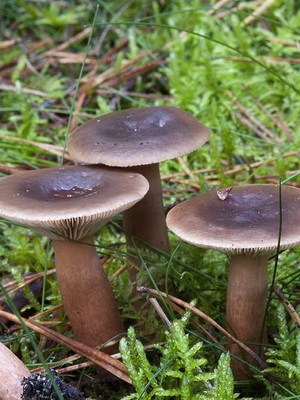
According to the photo and description, this type of milk mushroom is similar to the inedible hepatic milkweed (Lactarius hepaticus), the milky juice of which turns yellow noticeably in air; the edible camphor lactarius (Lactarius camphoratus), which has a characteristic camphor smell, and the marsh lactarius (Lactarius sphagnei), which grows only in swampy areas.
When it grows: from mid-July to the end of September in almost all countries of the northern half of Europe and Asia.
Where can you find it: on acidic soils of coniferous forests, less often in dense birch forests.
Bitter milk is suitable only for salting, and only after thorough soaking with a constant change of water (10-12 hours). This is done to remove bitterness. When interacting with brine, this type of edible milk mushroom darkens noticeably.
Application in traditional medicine: not applicable. However, scientists have learned to isolate from the bitter milkweed a substance that inhibits the growth of Staphylococcus aureus bacteria, hay and Escherichia coli.
Important! Bitter mushrooms can accumulate the radioactive nuclide cesium-137, which is deposited in the liver and muscles of humans and animals, so you should not collect this mushroom in areas of radioactive contamination. Other names: bitter, red bitter, mountain goat
Mushroom pickers call the bitter mushroom a traveler, as it is often found during the "quiet hunt"
Other names: bitter, red bitter, mountain goat. Mushroom pickers call the bitter mushroom a traveler, as it is often found during the "quiet hunt".
Yellow milk mushroom and pig: what are the differences
Pig is a poisonous mushroom that can be confused with a yellow mushroom. However, it looks much more like a black lump.
Until recently, the pig was classified as conditionally edible mushroom. But the recorded cases of death due to the consumption of this mushroom in food led to the fact that in 1984 the pig fell into the category of poisonous.
To distinguish this mushroom from milk mushrooms, it is important for a mushroom picker to know the characteristic "signs" of a pig, which include:
- a hat of yellow-brown or ocher-brown color, with a diameter of 17 centimeters and more;
- the pulp is light brown in color, which darkens when cut;
- plates that are easily separated from the cap;
- matte and smooth stem, the color of which is slightly lighter than the cap.

Cooking recipes
The violin belongs to conditionally edible mushrooms, which have been assigned the fourth category of edibility. When properly processed, it is safe for the body, therefore it is successfully used in cooking. Skripun can be cooked for future use, pickled, salt.
Primary processing and soaking
Before proceeding directly to the cooking process, it is necessary to carry out the primary processing of the fruit bodies in order to remove the milky juice from them.
Algorithm of actions:
- Go through the mushrooms.
- Remove adhering leaves, moss and dirt particles.
- Rinse thoroughly with running water.
Then you can move on to the soaking process, which will help get rid of the taste of bitterness, toxins and harmful elements. Soaking should be done in two ways:
- Immersion in cold water.It is necessary to place the mushrooms in salted liquid, in which they should remain for 5-7 days, periodically change it to fresh.
- Pouring boiling water over. This method is considered faster, after 3 days the mushrooms are ready for further processing. In this case, the water will have to be changed quite often - up to 5 times a day.
Is it possible to fry and boil the violin mushroom?
The violin is suitable for eating only in salted form. When boiling or frying, the bitterness in the fruit body is preserved, and when eating the violin prepared in this way, there is a risk of adverse effects.
Salting
Salty violin is much inferior in taste to white milk mushrooms. But if you find the right recipe, you can get a great snack with a pleasant aroma. For preparations for the winter, fruits with a large and fleshy cap are suitable. In this case, it is recommended to select whole and fresh fruit bodies without signs of worminess.
Hot
Ingredients:
- pre-soaked violin - 1 kg;
- table salt - 30 g;
- fresh currant leaves - several pieces;
- filtered water;
- allspice - a few peas;
- cloves - 2-3 pcs.;
- bay leaf - 1 pc.
Recipe:
- Pour water into an enamel pot, add salt.
- Place the mushrooms in it, blanch them for 20-30 minutes, constantly removing the foam.
- Throw in a colander.
- Wait for cooling.
- Put currant leaves on the bottom of the jar, add spices, add bay leaf.
- Lay the squeaks on top with the caps down, while sprinkling each layer with table salt.
- Cover with currant leaves on top, close the lid and refrigerate for 1.5 months.
Cold
Salt for the winter can be cold.
The following ingredients are required:
- felt mushroom - 1 kg;
- table salt - 50 g;
- bay leaf, cloves, peppercorns, garlic cloves - to taste;
- currant or cherry leaves - several pieces.
How to salt a violin:
- Put the mushrooms in a wooden container in dense layers, caps down, sprinkle each with salt and spices.
- Cover with a ceramic plate on top and place the load.
- Wait until liquid is released. It should cover the mushrooms completely, and if this does not happen, then top up with a saline solution prepared at the rate of 20 g of salt per 1 liter of water.
- Put the prepared squeak in sterilized jars, caps down.
- Cover the salting with currant leaves.
- Close with lids.
- Put in the refrigerator for 1.5 months.
Hot Crispy Pickled Squeaks
Felt milk mushrooms can also be pickled and rolled in jars. This process is more time consuming as the mushrooms need careful preparation. But, according to reviews, the pickled squeak is crispy and aromatic.
Ingredients:
- violin - 1 kg;
- water - 1 tbsp.;
- table salt - 40 g;
- onion - 1 pc .;
- cherry leaves - several pieces;
- horseradish leaf - 1 pc.;
- dill umbrella - 1 pc.;
- black peppercorns to taste.
Step-by-step pickle recipe:
- Peel and rinse the mushrooms in cold water at least three times.
- Cover with water overnight.
- In the morning, drain the water and rinse each mushroom under the stream again.
- Put in an enamel container, cover with water and bring to a boil, periodically removing the foam that appears.
- Throw in a colander or sieve.
- Rinse again and soak in cold water for half an hour.
- Drain the liquid, rinse the mushrooms several times.
- Prepare sterilized jars.
- Place spices on the bottom, a layer of mushrooms on top, rings of chopped onions and a horseradish leaf on them.
- Boil marinade water with salt and pepper.
- Pour the brine over the mushrooms, sterilize the jars for 30 minutes, roll up.
Benefit and harm
Milk mushrooms contain vitamins and minerals necessary for human health. Moreover, this mushroom has many beneficial qualities.
- The yellow mushroom is considered a rich source of protein, which is even more abundant in these mushrooms than in meat.Scraping is especially useful for vegetarians looking for additional sources of protein deficiency.
- Also in the yellow wave contains calcium, vitamins D and PP.
- Vitamin B, which is part of the mushroom, helps to cope with nervousness, stress and depression, strengthen nerves and maintain emotional stability.
- Low calorie content (12-16 kcal) will allow milk mushrooms to be consumed even by those who follow a diet and want to get rid of extra pounds.
- The high amount of fiber contained in the wave will provide a long-lasting feeling of fullness. Also, fiber helps to remove harmful substances from the body, help cleanse the blood and skin.
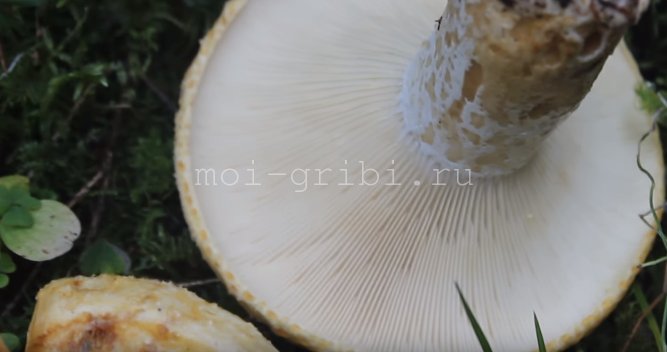
However, if improperly prepared or consumed excessively, the milk can harm human health and lead to stomach or intestinal upset.
Therefore, it is extremely important to follow the pretreatment process of the mushroom before cooking it.
Also, a yellow wave is contraindicated for people suffering from:
- kidney disease;
- diseases of the gastrointestinal tract (ulcer, gastritis);
- high blood pressure.
Pregnant women, as well as young mothers who are breastfeeding babies, should be treated with extreme caution. During these periods, the body may react unpredictably to different foods, so it is recommended to get a preliminary consultation with a doctor.
Finally, milk mushrooms should not be included in the diet of the elderly and children under 12 years of age. The body of both of them contains an insufficient amount of enzymes that contribute to the assimilation of the fungus.
Collection and procurement rules
 There are about 20 types of mushrooms, they are found in abundance in Siberia and the Urals, in the Volga region. They prefer moist sandy ground, slightly elevated and well-lit areas. Every mushroom picker knows how milk mushrooms grow in these places. After all, a strong and tasty mushroom is a real find for a gourmet! Only young mushrooms are suitable for food, the cap of which has not reached 8-10 cm in diameter. They are harvested in different ways - they are boiled, salted, pickled. Different types of milk mushrooms are combined with each other, so they can be pickled together.
There are about 20 types of mushrooms, they are found in abundance in Siberia and the Urals, in the Volga region. They prefer moist sandy ground, slightly elevated and well-lit areas. Every mushroom picker knows how milk mushrooms grow in these places. After all, a strong and tasty mushroom is a real find for a gourmet! Only young mushrooms are suitable for food, the cap of which has not reached 8-10 cm in diameter. They are harvested in different ways - they are boiled, salted, pickled. Different types of milk mushrooms are combined with each other, so they can be pickled together.
The collected mushrooms are sorted out, cleaned of foliage and branches. Then they are thoroughly rinsed in a basin until the water is clear. To remove bitterness, they must be soaked.  Soaking nigella takes longer than other types. The optimal soaking period is 4-5 days; the water should be changed twice a day. To finally get rid of the bitterness, soaked mushrooms are boiled for an hour in two waters.
Soaking nigella takes longer than other types. The optimal soaking period is 4-5 days; the water should be changed twice a day. To finally get rid of the bitterness, soaked mushrooms are boiled for an hour in two waters.
Black milk mushrooms are ideal for canning. Salt them cold and hot, most often whole or only caps. If a lot of mushrooms are collected, then they are prepared in a barrel in the old fashioned way, that is, they are laid in layers and sprinkled with salt. When finished, they take on a rich purple hue. The black milk mushroom is crispy and spicy to taste, it is suitable for the preparation of various appetizers and salads, hodgepodge. It is best to serve them on their own with onions and fragrant sunflower oil.
What a peppery milk looks like: photo and application
Family: Russulaceae.
Synonyms: peppermint.


Description. About what the pepper milk looks like in the photo above: the cap of the mushroom is white, yellowish with age or with brownish spots. It does not have concentric zones, its diameter is 5-20 cm. Externally, the cap is fleshy, dense, at first flat, with a curled edge, then concave, matte, not pubescent, dry. The pulp is coarse, dense, white, turns bluish-blue on the cut, with a pungent peppery taste and a faint smell of rye bread. Milky juice is very abundant, burning, white, turns blue or yellow in the air. The plates are white or creamy, very frequent, narrow. Stem 5-8 X 1-2.5 cm, dense, smooth, white, sometimes with yellowish spots.
Distributed in the temperate and forest-steppe zone of Russia, forms mycorrhiza with oak, birch and spruce, inhabits deciduous and mixed forests with the participation of these species. Fruiting in July-October.
Similar species.Skrypitsa (L. vellereus) is distinguished by milky sap turning brown in the air and rare plates. Milk parchment (Lactarius pergamenus) has a longer stem.

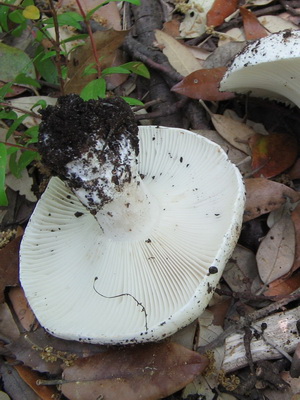
Pay attention to the photo: this type of milk has a wrinkled cap and a white podgruzdok (Russula delica), characterized by the absence of milky juice and non-caustic pulp (pungent plates). The medicinal properties of peppermint
Hot aqueous extract of L. piperatus showed anti-cancer activity by inhibiting sarcoma-180, Ehrlich carcinoma and Lewis pulmonary adenoma
The medicinal properties of peppermint. Hot aqueous extract of L. piperatus showed anti-cancer activity by inhibiting sarcoma-180, Ehrlich carcinoma and Lewis pulmonary adenoma.
The methanol extract of fresh fruit bodies showed antibacterial activity against pathogens such as Escherichia coli, Proteus vulgaris and Mycobacterium smegmatis, and no antifungal activity against Candia albicans. Recent additional studies have found that the level of antimicrobial activity is highly dependent on the age of the fruiting bodies, is highest in young mushrooms and almost absent in mature mushrooms that begin to disperse spores.
The same applies to antioxidant activity, which is high in young fruiting bodies and low in old ones. The antioxidant activity of peppermint is expressed in a decrease in the number of free radicals, inhibition of oxidative hemolysis in erythrocytes and inhibition of lipid peroxidation.
Traditional and folk medicine. In Chinese medicine, the mushroom is used to relax muscles and relieve muscle cramps.
In Russia, the milky juice of pepper milk was used to remove warts and in acute purulent conjunctivitis (a cloth moistened with milky juice was applied), and slightly toasted fruiting bodies - in renal and cholelithiasis. There are known attempts to use the fungus in the 19th century against tuberculosis (it is believed that they were ineffective).
Cooking Uses: Used for pickling and pickling. To remove the pungent taste, it is pre-boiled and / or soaked. In the Caucasus, it is sometimes dried, ground into powder and used as a hot seasoning instead of pepper.
Growing at home and in the country
Felt mushrooms can be harvested not only in forests, but also grown at home. This process is not particularly difficult, you just need to purchase a ready-made mycelium.
When growing, the following algorithm of actions must be observed:
- Mix mycelium with forest soil and hardwood sawdust.
- In places where many squeaks grow, collect moss and rotten foliage.
- Sow mycelium. Sowing can be done from late spring to early autumn.
- Make a nutrient solution from yeast and sugar for feeding.
If it was not possible to get ready-made mycelium, then you can try another method:
- Break the overripe mushrooms into small pieces.
- Mix them with peat and sawdust.
- Drizzle with nutrient solution.
- Cover with small holes.
- Leave for three days indoors at a temperature of about +23 degrees Celsius.
- Prepare the soil by treating it before planting with a solution of lime prepared at the rate of 50 g of substance per 10 liters of water.
- Make the holes closer to the deciduous tree.
- Place the prepared substrate in the well, filling it up to half.
- Lay the mycelium in the next layer and cover it with lime and soil on top.
- Cover with moss and rotten leaves.
Real milk mushroom: photos and properties
Family: Russulaceae.
Synonyms: white milk mushroom, raw milk mushroom, wet milk mushroom, pravsky milk mushroom.
Description. The cap is large, 10-20 cm in diameter, at first white, rounded-convex or almost flat, then funnel-shaped, with a furry edge turned down, slightly yellowish, with barely noticeable watery annular zones.

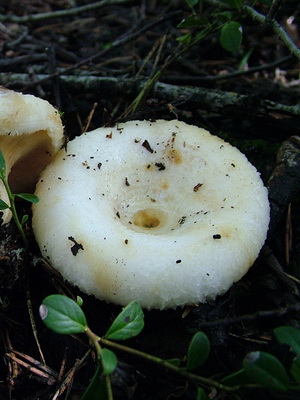
Pay attention to the photo of a real load: the surface of its cap is very slimy, especially in wet weather.The pulp of the mushroom is white, dense, fleshy, firm, with a pleasant specific aroma
The milky juice is white, pungent, bitter; in the air it immediately becomes sulfur-yellow. The plates are white or cream, with a yellowish edge, wide, sparse. The stalk is strong, even, 3-5 X 1.5-3 cm, naked, white, sometimes with yellowish spots, when ripe it is hollow inside.


This type of mushroom is common in the temperate zone of Russia, in birch forests, forests with the participation of birch, not often, but in places abundantly. Fruiting in July-October.
Similar species. Despite the presence of many other white milkers, the real milk mushroom is too characteristic to be confused with something.
Application in folk medicine: The properties of the mushroom make it possible to use this mushroom in diseases of the stomach and blennorrhea (acute purulent conjunctivitis).
Collection and procurement rules: Young fruiting bodies are collected, used boiled without salt (stomach diseases). For the treatment of blenorrhea, milky juice is collected.
Cooking Uses: Considered the tastiest of the milk mushrooms. Requires preliminary boiling and / or soaking, used for salting and pickling, sometimes for frying (after boiling).
Where the lump grows
White mushroom grows mainly in the northern regions, but occasionally it can also be found in other climatic regions. If you go on a "quiet hunt" for these particular mushrooms, you should know that they prefer to grow in deciduous and mixed forests, and they are most often found near birches, since the fungus forms mycorrhiza with the roots of this particular tree. It makes no sense to look for these mushrooms in more often, since they prefer wet and moderately lit meadows, glades and forest edges. Milk mushrooms are mushrooms with a slow growth rate (0.2-0.3 cm per day). It takes about a week for them to fully ripen.
Going into the forest for these mushrooms, you should also know that the peak of their fruiting occurs in late summer or early autumn (depending on the climatic region). But, if autumn is warm, they can be found in October as well. It should also be borne in mind that in hot weather, fruiting bodies develop poorly, therefore, it is better to go after prey with the onset of cool rainy weather.
Milk mushrooms love moist, mixed coniferous forests. Appear after heavy warm rains. Like all lamellas, they grow in families, and very quickly: a couple of days - and the "glade" is ready, you can collect it again. Milk grows in 3-5 days to medium size and continues to grow for 10-15 days
The diameter of the cap and the height of the mushroom per day increase by 1 -1.5 cm. Pay attention to the abandoned mows near the forest - often milk mushrooms grab the edge of the clearing.
To a decisive extent, the growth rate of mushrooms depends on the temperature and humidity of the soil and air. The most favorable temperature in the forest is about 22 ° C, and the humidity is 80-85%. Mushrooms do not like excessive humidity and hot weather. In warm, but not hot weather, they grow faster than in cold weather. A significant increase in the growth of fungi is noted after warm, quiet rains, the appearance of fogs. Low air humidity and dry soil cause their growth to stop. It also occurs as a result of infestation of fruit bodies with mosquito and fly larvae.
Consider in which regions of Russia milk mushrooms are most common:
- Many of these mushrooms grow in the Krasnoyarsk Territory. These are Arey, Emelyanovo, Uzhur, Kurtak, the vicinity of Uyar, Bartat, Shchetinkino.
- In the Chelyabinsk region, mushrooms can be found in the forest on the western side of Lake Bolshoy Kremenkul, in the forests along the Kyshtym-Ozersk highway, the surrounding Kasley forests are also rich in mushrooms, in the forests around the village of Kureinoe, in the forest around the village of Tomino.
- In the Vladimir region, the villages of Efimovskaya and Smykovo, the village of Demukhino, Ilyino, Muromtsevo (Sudogodsky district) are famous for their mushrooms. The village of Pervomaisky (Selivanovsky district), Boldino (Sobinsky district) in the direction of Koloksha.
- In Transbaikalia, milk mushrooms grow in the Tunkinskaya Valley, not far from Irkutsk in the village of Pivovarikha.
- The southeast of the Sverdlovsk region is ideal for picking milk mushrooms.In the north of the Middle Urals, there are also milk mushrooms, but in smaller quantities, and not everyone will follow them into the deep taiga. Excellent places near the stations Reshety, Sportivnaya, Novoalekseevskaya, near Kamyshlov.
Collected milk mushrooms
Real milk
Real photo
Systematics. Class - Basidiomycetes, order - Russulales, family russula - Russulaceae, genus Mlechnik - Lactarius.
Real lactose - Lactarius resimus... Real milk mushroom is also called raw milk mushroom, white milk mushroom (Ural, Volga region), pravsky milk mushroom (Siberia), wet milk mushroom (Kazakhstan, Western Siberia).
Collecting mushrooms is like hunting. It is necessary to get up early, at about six o'clock in the morning. Otherwise, the risk of finding cut legs increases.
The search for the fungus is carried out in birch forests, since the real milk mushroom forms mycorrhiza with it - a symbiosis of the mycelium of the fungus with the roots of the tree.
Walking through the forest, you need to look very carefully at all the irregularities and bumps of the soil, especially near the stumps and under the birches, since the cap may be completely hidden under the fallen leaves or needles. Milk mushrooms do not like light, therefore they grow mainly in dark, humid places, slightly nestling on the ground. For convenience, you can take a long stick with you and use it to check the contents of the tubercles.
The real description
Diameter hats 5-20 cm, initially flat-convex, later acquires a funnel-shaped shape with a pubescent edge wrapped inward, dense.
Skin milky white or slightly yellowish, wet, slimy, has unclear concentric zones, most often with adhering particles of litter and soil.
Leg 3-7 cm in height, 2-5 cm in diameter, smooth, cylindrical, white or slightly yellowish, sometimes with yellow pits or spots, hollow.
Pulp mushroom is strong, dense, white, with a characteristic odor that resembles that of fruit. Milky juice tastes pungent, white, becomes sulfur-yellow in the air. The mushroom is moist to the touch, even in dry weather.
LPs fungus are quite frequent, slightly descending along the stem, wide, white with a yellowish tinge.
Spore powder yellowish in color.
The variability of the mushroom is real
In old mushrooms, the plates turn yellow, the leg becomes hollow. There may be a brown spot on the cap. The color of the plates can vary from yellowish to cream in color.
Ecology and distribution of the fungus
Found in mixed and deciduous forests: pine-birch, with linden undergrowth, birch. Forms with birch mycorrhiza... Distributed in the North of Russia, in Western Siberia, in the Urals, in Belarus, in the Upper and Middle Volga regions. Grows in large groups. Not common.
For favorable fruiting, the optimum temperature is 8-10 ° C on the soil surface. Season - July-September, in the southern regions (Middle Volga region, Belarus), August-September.
The edibility of the mushroom is real
Milk is a real edible or conditionally edible mushroom of the 1st category.After collecting the mushrooms, they begin to process them. The mushrooms are cleaned, washed, cut off the legs with mycelium particles, put them in a container with water and sprinkled with salt. Salting milk mushrooms is a troublesome business. Soaking is carried out for at least three days. In this case, it is necessary to change the water three times a day. Thus, toxic compounds are removed from the mushroom, because of which it is considered conditionally edible.
Real photo:
Real photo
The classic cold way of pickling milk mushrooms
Before salting, the mushrooms are soaked in salted and acidified water (10 g of salt and 2 g of citric acid per 1 liter of water). Soaking is carried out for 2 days, while the water is changed in the morning and evening. Then the mushrooms are placed on the bottom, in prepared containers, caps down, sprinkling with salt at the rate of 40-50 g per 1 kg of mushrooms. When the container is filled, the mushrooms are covered with a clean cloth, a circle is placed on top and a small weight is placed on it. After 2-3 days, the mushrooms become denser and juice is released, a new portion of mushrooms is added to them, observing the same rules.This is done until the sediment of the mushrooms stops. Do not remove the load! The mushrooms must be covered with the formed brine. If it is not enough, then you can add salted boiled water and increase the weight. The filled containers are taken out in the cold for 35-40 days.
Milk mushrooms: what they look like and where they grow

Milk mushrooms are one of the most revered in Russia. A favorite old Russian dish, a real "royal" appetizer, is salted milk mushrooms in barrels, but you can use these gifts of the forest to prepare other dishes. Do not forget that inedible varieties of milk mushrooms are also found in the forest, for example - g. Papillary and g. Fluffy. Conditionally edible species are also known: g. Tender and g. Aspen. In their natural habitat, real milk mushroom is found in a variety of forests, especially often in birch and pine-birch. It has a fairly wide (up to 20 cm), convex-flat, then funnel-shaped cap with a fibrous wrapped bottom. The surface of the cap is slimy, white, maybe creamy yellow with barely noticeable concentric stripes. The flesh is well developed, dense, brittle, white, does not change color at the break, with abundant burning milky juice, yellowing in air, with a slight mushroom odor. The plates are narrow, descending, frequent, branched, white with a yellowish margin. The stem is cylindrical, hollow at maturity, white, sometimes with yellowish spots. The beet is a conditionally edible mushroom. It is not used fresh because of the caustic milky juice. High quality products in salty form are produced after thorough soaking. Salted milk mushrooms are a favorite dish of Russian cuisine. Check out the photos and descriptions of different types of milk mushrooms.
What a real mushroom looks like (white): photo and description
Category: edible.


Other names: white milk mushroom, raw milk mushroom, pravian milk mushroom, wet milk mushroom.
Since the beginning of the XIX century. in Russian scientific circles they called peppercorn - Lactarius piperatus. But in 1942 the scientist-mycologist Boris Vasilkov proved that the people consider the species Lactarius resimus to be the real one.


Above you can see what the white lump looks like in the photo. Its cap (diameter 6-25 cm) is white or yellowish. In young mushrooms, it is flat, but over time acquires the shape of a funnel. On the edges bent towards the inner side, there is almost always a noticeable fluff. It is sticky and very wet to the touch.


If you look closely at the photo of a real mushroom, you can almost always notice plant debris on its hat, which sticks to the mushroom more often than to other mushrooms.
Leg (height 3-9 cm): white or yellowish, cylindrical, hollow.


In the photo of a real weight, frequent plates of white or yellowish color are clearly visible.
Flesh: white with white milky juice, which, when exposed to air, turns dirty yellow or grayish. The smell is similar to that of fresh fruit.
Doubles: white podgruzdok (Russula delica), the main difference of which is the absence of milky juice in the latter. The violin case (Lactarius vellereus) also looks like a white lump, only its hat is more “felt” and there is no cannon. White boll (Lactarius pubescens) is much smaller in weight and with a more pubescent cap. Aspen milk mushroom (Lactarius controversus) grows under aspen trees, where real milk mushrooms are practically not found. And the milky juice of peppercorns (Lactarius piperatus) turns green when it interacts with air.
The white mushroom grows from the beginning of July to the end of September in the Volga region, Siberia and the Urals.


Where to find it: In deciduous and mixed forests near birches.
Eating: salted after a long boil to remove bitterness. Under the influence of brine, juicy and fleshy real milk mushrooms acquire a bluish tint, and after 40 days you can already enjoy their taste. In Siberia, according to tradition, real milk mushrooms are still salted along with volushki and mushrooms. During the famous 1699 mealArchbishop Andrian of Moscow and All Russia, apart from other dishes, the guests were served “three long pies with mushrooms, two pies with milk mushrooms, cold mushrooms with horseradish, cold milk mushrooms with butter, milk mushrooms heated with juice and butter ...”. In Western Europe, a real mushroom is considered an inedible mushroom, and in Russia it has long been called the king of mushrooms. A real milk mushroom surpasses even fatty meat in calorie content: in dry matter, the protein content reaches 35%.
Application in traditional medicine (data have not been confirmed and have not undergone clinical trials!): In the treatment of renal failure and urolithiasis.







